The Angelbird Wings PX1 M.2 Adapter Review: Do M.2 SSDs Need Heatsinks?
by Billy Tallis on December 21, 2015 8:00 AM ESTSequential Write
Sequential writes are easier for the SSD controller to process than random writes, so throughput is almost always higher and the bottleneck in this test shifts more to the flash itself. This test puts the most intense load on the flash out of any of our tests, and usually produces the highest overall power consumption. The timing of the sub-tests is the same as for the random tests, and the drive is filled before the test so that features like SLC write caching don't distort the beginning of the test.
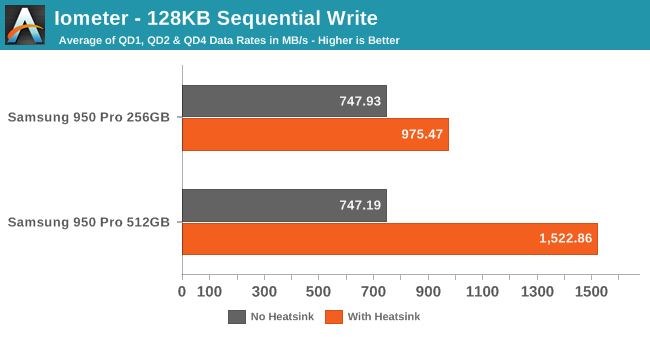
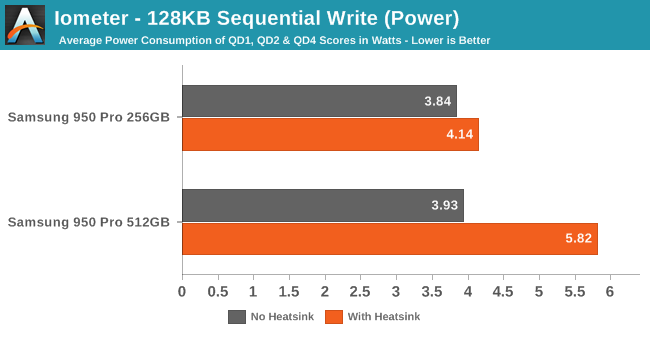
The heatsink provides a nice boost to the 256GB 950 Pro's sequential write speed, but doubles the sustained performance of the 512GB model. Power efficiency is still improved, especially for the 512GB drive, but it's now reaching almost 6W.
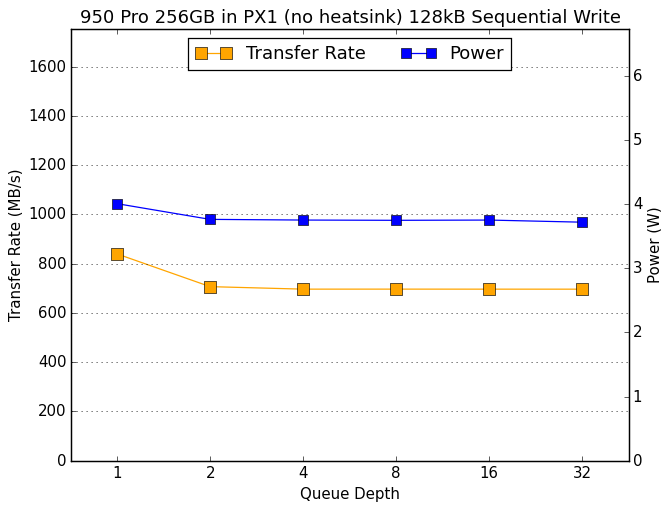 |
|||||||||
| 256GB no heatsink | 512GB no heatsink | ||||||||
| 256GB with heatsink | 512GB with heatsink | ||||||||
Without the heatsink, both drives experience thermal throttling only a few minutes into the test, with QD2 performance lower than QD1. With the heatsink, both drives show steady performance across the entire test. The 256GB improves QD1 performance slightly while the 512GB drive sees a 73% increase in QD1 performance. At queue depths greater than one the performance improvements are even larger.
Sequential Read
With the lower overhead of sequential operations and the inherent speed advantage reads have over writes, the sequential read test usually produces the highest throughput numbers. For SATA drives nowadays this usually means the SATA interface itself is the bottleneck, but even with NVMe we haven't seen a drive yet saturate the bandwidth of a PCIe 3.0 x4 link. Depending on the drive, this test could be limited by bottlenecks in the SSD controller's host interface or its connections to the flash memory.
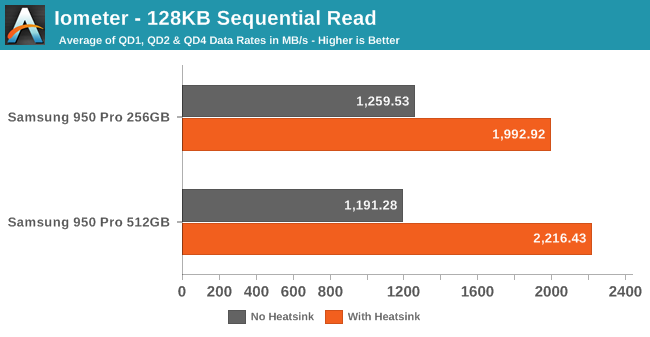

Both capacities see significant gains in sequential read performance, accompanied by smaller but still significant increases in power consumption. The 512GB drive once again manages to double sustained performance, and the 256GB improves by 58%.
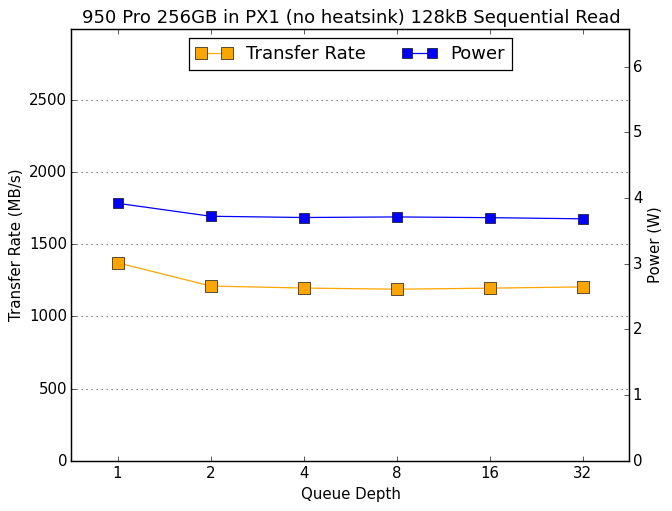 |
|||||||||
| 256GB no heatsink | 512GB no heatsink | ||||||||
| 256GB with heatsink | 512GB with heatsink | ||||||||
Again we see that the drives can't scale with higher queue depths when they're thermally constrained, but when properly cooled they perform superbly with any queue depth larger than one. The 512GB drive manages to deliver slightly more than 2.6GB/s read speed, well above what can be achieved with PCIe 2.0 x4 and about two thirds of the capacity of the PCIe 3.0 x4 link used by the 950 Pro.










69 Comments
View All Comments
Refuge - Tuesday, December 22, 2015 - link
It is supply and demand, not just charge 10% more than BoM on our entire product catalogue. Loljoex4444 - Tuesday, December 22, 2015 - link
You're also changing the interface from SATA-III to PCIe 3.0 x4. One of these things is mature and common as dirt, one of them is not.Ethos Evoss - Sunday, December 27, 2015 - link
I already have it on the laptop :)damianrobertjones - Monday, December 21, 2015 - link
It's the future... until they change it due to wanting people to spend more $$$$ to replace what they already have.TelstarTOS - Wednesday, December 23, 2015 - link
Not at all. U.2 is the future. M2 drives capacity is crippled.Teizo - Monday, December 21, 2015 - link
Having LED's on this product will only help sales if it is full RGB so people can adjust the lighting to match their system. Mix/Match lights is a major detraction/distraction for people who go to great lengths to color coordinate their systems.mooninite - Monday, December 21, 2015 - link
Meanwhile there are starving children in Africa. Geeze...tipoo - Monday, December 21, 2015 - link
You could say that about practically everything on sites like this, so kindly get off that high horse.Teizo - Monday, December 21, 2015 - link
Irregardless of your high minded comment, what I stated was in fact true. They decided, more than likely, that LED's would help with sales because gamers and enthusiast love LED's...but a little more thoughtful digging into things would reveal that the ability to color coordinate is pivotal when adding LEDs into system builds. Those kids in Africa are thrilled with your monthly monetary contribution, btw. There should be more people like you in the world.Demiurge - Monday, December 21, 2015 - link
You know, since the LED's are white... you could, y'know... buy a translucent material of the color of your choice and cover the card LED's with that and get the desired effect... without pestering the company to pander to waste money on that many RGB LED's at which you'd complain about the lack of a competitive price and not buy it anyway followed by you buying one without that is cheaper and buying a an LED strip yourself and attaching it...